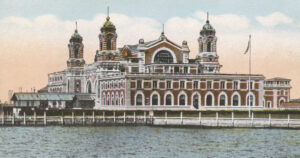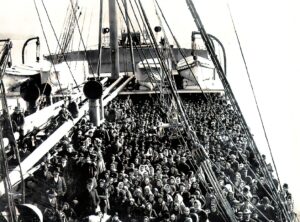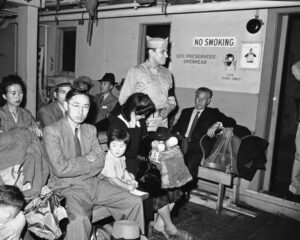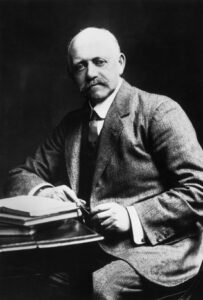By Suzanne Sparrow Watson
Well, so far, I have not been burgled by the Chilean crime tourists, but I came very close. One evening two weeks ago, a trio of them were caught by our security department trying to get into our community. Around 8:30, just when I was settling down with my book, I heard helicopters overhead. For the next seven hours police helicopters circled over my house and directed their floodlights into my front and back yard several times. They were shouting from their bullhorns, “Come out, with your hands up!”. I assumed they meant the burglars and not me. Thankfully by 6:30 the next morning they caught them. That’s the good news. The bad news is that their presence in our city has generated a lot of conversation about out our immigration and visa policies and, as is usual these days, the “conversations” soon devolve into political debate. People WRITE IN ALL CAPS in the hope it will make their point more factual. Coincidentally, last week I received an email from the history site I subscribe to that contained a piece about Ellis Island. Although I am unofficially the family historian, I’ve never paid that much attention to Ellis Island, as both our maternal and paternal great-grandparents immigrated from Europe between 1854 and 1880, before Ellis Island was established. I thought in light of the current national debate about immigration it might be useful to look back at our previous methods of screening immigrants. I learned a lot. Okay, maybe my previous knowledge was a low bar, but I hope this piece also provides some new insights for you too.
 First, the basics. Ellis Island was the designated as the official federal port of entry from Europe in 1892. Prior to that, immigration policies had been handled at a state level. Up until the late 1880’s, most immigrants to the U.S. were from Germany, Ireland, Britain and the Scandinavian countries. But political and economic turmoil in other parts of Europe caused a surge in immigrants to the U.S. Among this new generation of immigrants were Jews escaping czarist Russia and eastern Europe, as well as Italians escaping poverty in their country. There were also Poles, Hungarians, Czechs, Serbs, Slovaks and Greeks, along with non-Europeans from Syria, Turkey and Armenia, fleeing for the prospect of a better life in America. Due to the influx of “new” immigrants, congress acted to establish immigration policies at a national level. So, a whopping $75,000 was appropriated for construction of the first federal immigration station on Ellis Island.
First, the basics. Ellis Island was the designated as the official federal port of entry from Europe in 1892. Prior to that, immigration policies had been handled at a state level. Up until the late 1880’s, most immigrants to the U.S. were from Germany, Ireland, Britain and the Scandinavian countries. But political and economic turmoil in other parts of Europe caused a surge in immigrants to the U.S. Among this new generation of immigrants were Jews escaping czarist Russia and eastern Europe, as well as Italians escaping poverty in their country. There were also Poles, Hungarians, Czechs, Serbs, Slovaks and Greeks, along with non-Europeans from Syria, Turkey and Armenia, fleeing for the prospect of a better life in America. Due to the influx of “new” immigrants, congress acted to establish immigration policies at a national level. So, a whopping $75,000 was appropriated for construction of the first federal immigration station on Ellis Island.
 The new Ellis Island port of entry opened on January 1, 1892, on six acres of land. Each arriving passenger (almost all immigrants arrived by ship) went through an inspection process that lasted about two hours. Doctors would examine immigrants for signs of physical ailments or mental illness; at one point, they would flip back people’s eyelids to look for a contagious eye disease. If an immigrant had one of these problems, then a letter symbol would be drawn on his or her jacket with chalk — for example, E for eyes or X for suspected mental problem. And contrary to popular belief, the process did not involve changing one’s surname to one that’s easier to pronounce, which is one of the biggest myths that persists about Ellis Island. If names were changed, that would happen earlier, when the ship’s manifest was written in Europe at the home country’s consulate. Overall, despite these procedures, only two percent of immigrants were turned away.
The new Ellis Island port of entry opened on January 1, 1892, on six acres of land. Each arriving passenger (almost all immigrants arrived by ship) went through an inspection process that lasted about two hours. Doctors would examine immigrants for signs of physical ailments or mental illness; at one point, they would flip back people’s eyelids to look for a contagious eye disease. If an immigrant had one of these problems, then a letter symbol would be drawn on his or her jacket with chalk — for example, E for eyes or X for suspected mental problem. And contrary to popular belief, the process did not involve changing one’s surname to one that’s easier to pronounce, which is one of the biggest myths that persists about Ellis Island. If names were changed, that would happen earlier, when the ship’s manifest was written in Europe at the home country’s consulate. Overall, despite these procedures, only two percent of immigrants were turned away.
From 1900 to 1914—the peak years of Ellis Island’s operation—an average of 1,900 people passed through the immigration station every day. Most successfully passed through in a matter of hours, but others could be detained for days or weeks. The record for the number of people processed in a day was April 17, 1907, when more than 11,747 people passed through Ellis Island. April 1907 was, in fact, a banner month for Ellis Island, with more than a quarter-million passengers from around the world coming through. That year was Ellis Island’s peak year, as more than 1.2 million immigrants came to the United States. Immigration slowed after that in part due to a new federal law excluding persons with physical and mental disabilities, and children arriving without an adult.
World War I caused a huge drop in immigrants, from 178,416 in 1915, to 28,867 in 1918. The military took over the island during World War I to use as a place where injured soldiers could be sent after the war for recuperation. In 1917 a literacy test is introduced for all immigrants; it stayed on the books until 1952. Those over the age of 16 who could not read 30 to 40 test words in their native language were no longer admitted into the country. Nearly all Asian immigrants were banned for no other reason that just being Asian.
In 1921 President Harding signed the Emergency Quota Act into law, which stated that annual immigration from any country could not exceed 3 percent of the total number of U.S. immigrants from that same country, as recorded in the census of 1910. The Immigration Act of 1924 went even further, setting strict quotas for immigrants based on country of origin, including an annual limit of 165,000 immigrants from outside the Western Hemisphere. Interestingly, by 1932 the Depression had taken hold in the U.S., and for the first time ever, more people left the country than arrived.
From the 1920s to 1950s, Ellis Island was mostly used as a detention center; during World War II specifically, it served as a detention center for “enemy aliens” who were Japanese, German or Italian. After the war, with the advent of modern air travel, immigration points were established throughout the country and Ellis Island fell into disrepair. It was permanently closed in 1954 and was not reopened until 1990, when it became a museum.
I found the history of Ellis Island fascinating and given its history and all that has happened since its closure, it’s clear there is no simple answer to immigration policies. Although little common sense in Washington DC might go a long way. Maybe we need to re-institute an immigration law from 1875 and impose it on Congress: it restricted “lunatics” and “idiots”.













